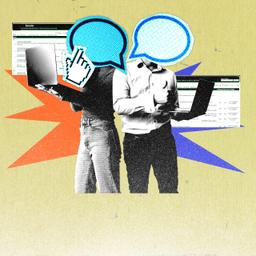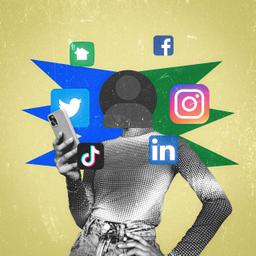The 10 People You Meet on LinkedIn
LinkedIn is a bizarre, blustery platform that, over 21 years, has gone from a suped-up Rolodex to a modern digital break room. And there, you can find everyone from founders to celebrities to that quiet kid from your econ section who’s all about the grindset.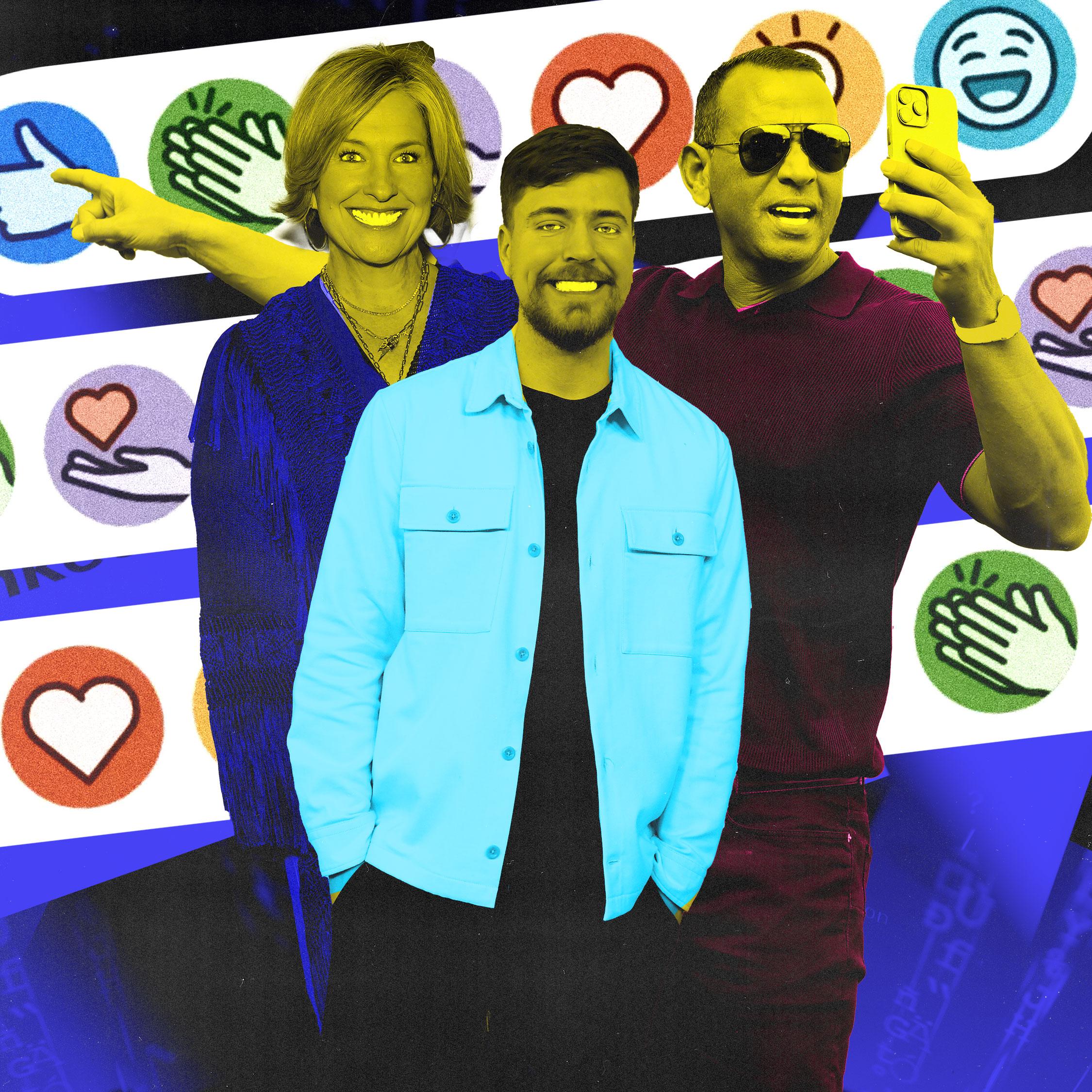
Not long after I moved to California in 2011, I got to chatting with a friend-of-a-friend who was halfway through business school and road-mapping her next steps. One potential option, she told me, was going back to where she’d worked over the summer. “Enterprise sales,” she explained. “Exciting, I know.” She was being droll, but actually, it was kind of exciting—I’d never known anyone with that job before!
I had many questions, which she answered politely and with mounting confusion. What was her connection to the industry? Recruiters come to the campus career center every year to interview students. What was the day-to-day like? Phone calls and emails and meetings—it’s all the same. Did she ever borrow a midsize SUV for a few hours as a perk of the job? Uh, so, the company had a commuter bus from Alamo Square that I took … OK, sorry, final question: Were the summer sales interns ever asked to go and, like, work shifts at the airport counter? Just to see, soup to nuts, how the whole car rental process actually wor—
“Wait, the airport?” she hooted. And that’s how I first learned, all the way in my late 20s, that when a Bay Area B-school student speaks of a fledgling career in “enterprise sales,” it almost certainly does not have anything to do with the rent-a-car company.
I tell this story because it’s pretty much how I feel every time I log in to LinkedIn, the résumé-boosting-and-boasting online hub that’s your favorite enterprise saleswoman’s least favorite enterprise saleswoman’s favorite networking site. All the elements of the social network are right there: idle chats about career paths! Two millennials courteously misunderstanding each other! Me finding out for the very first time about entire tranches of lucrative employment options!
I also tell this story because it’s an anecdote that can be wrapped up nicely with either of two classic LinkedIn-linked punch lines:
(1) Hi, I’d like to add you to my professional network on LinkedIn. (Identified in 2015 as a nü-universal New Yorker cartoon caption—though of course Christ, what an asshole will always be the GOAT.)
or
(2) Here’s what it taught me about B2B sales. (More on that momentarily.)
Founded in 2003—a faraway time just before Facebook ate society—LinkedIn is now old enough to drink responsibly (or otherwise) at the corporate Christmas party. Once an early-aughts start-up trying to compete with the likes of Orkut and Ryze, LinkedIn has had a ryze of its own that included being acquired by Microsoft in 2016 for $26.2 billion.
Just as real-world workplaces and broader job markets have evolved over the 21st century, their digital break room has changed, too. Early renderings of LinkedIn were populated in large part by the Silicon Valley geek lords that built it. But as the site grew, it started to resemble the open-concept business spaces that were taking over IRL, with users from every department and industry out there in one big jumble of connections and distractions, operating and eavesdropping all the while. These days, while LinkedIn still captures the feeling of an office, that office is increasingly the kind that’s outfitted with a boom mic and a ring light. You can now find influencers not just on LinkedIn, but of LinkedIn, forged in the crucible of all those sales funnel strat posts and all that headhunter humor.
Once a suped-up Rolodex, modern LinkedIn features videos and reported articles and polls and word games—and robust discussion in the comments about the word games. Each day, enough users are up and at ’em, living the grindset and posting about it, that an entire subreddit community is kept busy parsing their output. So in celebration of this bizarre, blustery platform, I tried my best to round up, in loose chronological order, the types of LinkedIn users that have defined the service over the years, for better and for worse. Or, more corporate-speakily: in times of strength and in times of opportunity. #LiveToWork
1. The Founder
Compared with some of his early-21st-century online startup contemporaries, Reid Hoffman has never been particularly recognizable. He didn’t plaster an avatar of his face all over his company web site, a la Tom from MySpace. He wasn’t, and still isn’t, a paparazzi-attracting household name like Mark Zuckerberg, despite having amassed a fortune of many, many, many billions of dollars. You may not be able to picture Hoffman offhand—and yet you’re probably one of the billion(-ish?) people to have patronized LinkedIn, the business he built in his image. On his website, Hoffman has an annotated copy of the presentation deck he used to pitch LinkedIn for a Series B investment in 2004. The first page says:
Find and Contact the People You Need
Through
the People You Already Trust
Two decades later, this vision holds! A Bay Area baby, Hoffman has long been beguiled and enriched (and also compromised) by the power of proximity and the force multiplier of physical and interpersonal networks.
He is a human résumé, a walking action item, a PayPal Mafia don. He's the guy who first connected young Zuckerberg with Peter Thiel for one of Facebook’s earliest angel investments. “He wants to be the new George Soros who is pulling the strings”—at least, according to a source in a New York Post article about Hoffman’s political mega-contributions. He teaches a class at Stanford called “Technology-Enabled Blitzscaling” based on one of the handful of books he’s written, and he has a new book, Superagency: What Could Possibly Go Right With Our AI Future, set to publish soon. All of which is to say that not only is he the founder of LinkedIn, he is also linked in—and to an uncanny degree.
2. The Skeptic
LinkedIn has grown so entrenched in corporate society these days that it’s easy to forget it spent the first part of its existence as just one more social networking startup in a landscape full of ’em. The LinkedIn Disbeliever isn’t around as much now, but early in the platform’s arc, there was plenty of concerned chatter about its utility and ceiling.
In 2003, Forbes compared a trio of new internet businesses, noting that in the year-ish before publication, “Friendster rocketed to 3 million registered members, compared with 85,000 for LinkedIn and Tribe combined.” (MySpace was released that same year, while Facebook launched in 2004.) In 2007, a columnist for the Harvard Business Review sniffed that “LinkedIn is explicitly for business purposes, so it’s not social networking. Secondly, I would argue that LinkedIn isn’t terribly useful unless you are seeking a job or a favor from someone you don’t know.”
Luckily for LinkedIn, “seeking a job or a favor from someone you don't know” is a big part of what this life’s all about, and the service managed to overcome its staid reputation (as well as an era that featured some questionable ad strategies) to become the industry leader in signing up leaders of industry—and their followers, too. According to the company, there are now more than a billion members on LinkedIn. And according to my estimates, each and every single one of them has looked up either an ex or a bully within five minutes of joining—only to learn, with mounting horror, that their click almost certainly generated an “Your Profile Is Being Seen!” email narcing them out.
3A. Your Best Friend—or So You Thought
3B. This One Quiet Kid From Your Econ Section Whose Learnings, Webinar Links, and Conference Panel Photos Comprise a Solid 43 Percent of Your Feed
Ah, the Scylla and Charybdis of the modern-day career journey! Hazards that can rock your boat if you veer too close or look too long. As a longtime Internet traveler, I have surfed onto the shores of many an online community over the years. (I was even on eWorld, which Hoffman worked on during his first job at Apple!) But LinkedIn is unique in that clicking on the profiles of people whom I’ve actually crossed paths with in life tends to leave me disoriented and adrift.
Not sure I’ll ever get used to idly looking up a close friend, picturing their silly goose face in my mind, only to be jump-scared by a swept-clean, gray scale corporate headshot instead. (I am sure that I hate the fact that they’re probably having the same experience with my profile pic.) Much gets made about “bringing one’s whole self to work,” but the true paradigm-shifter is encountering a friend’s work self in the wild. Wait—you mean to tell me that the godmother of my child has been using solution as a verb all this time? It’s not my business what anyone does behind closed glass conference room doors, but it’s just that you think you know a person, and then you come to find out that they’re—how do I put this—eager to leverage mindshare. In this economy?!
Then there’s the opposite type: the person I only knew ever so scarcely, but whom I now fear I may never escape. This genre of LinkedIn user has said, at most, a cumulative sentence out loud to me or anyone I knew during all the years we were classmates—but now, he posts twice-daily wantrepreneurial broetry on his page along with clips of himself being interviewed on podcasts about fractional executives and go-to-market mojo dashboards. Well, supposedly being interviewed, anyway: I often notice the camera conveniently never flips to an interviewer. Fake it til you make it, king!
Who knows, though: Chances are, one day I’ll be thanking that guy. Recently, a longtime social theory called "the strength of weak ties” was revisited with a study that revolved around LinkedIn. One takeaway: When they say your network is your net worth, don’t discount distant acquaintances! Turns out the best leads on career opportunities are the ones that come through some remote rando as opposed to a bestie. (I’m paraphrasing the science a bit here.) It’s a trip knowing that you might wind up getting the best return on capital you didn’t even know you were spending.
4. Lloyd Blankfein’s Harvard Buddies
Probably the number one reason it took me years to join LinkedIn was that, a few months after the social network’s IPO in 2011, I saw this tweet from New York features icon Jessica Pressler:
She had been only the latest victim of what was, for a time, one of LinkedIn’s most aggro growth strategies. A new user clicking through the onboarding flow could easily miss a preset option that allowed LinkedIn to send an email—from that user’s personal email address!—to … everyone. “People I have apparently invited to join LinkedIn: Channing Tatum, Emma Stone, every ex-boyfriend, editor wondering where my story is #ohgod,” Pressler wrote, adding: “Shout-outs to Lloyd Blankfein's Harvard buddies for accepting my accidental LinkedIn request. #thegreatlinkedindisasterof2011”
My own contacts weren’t remotely this prestigious, but it still sounded like my worst nightmare and loomed large in my mind for a full decade. It sure didn’t help when I got one of these emails from my own dad!
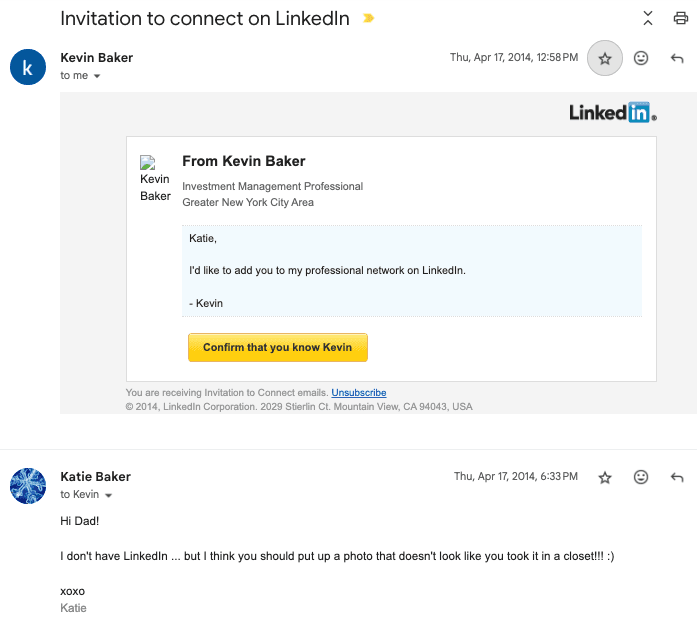
This was par for the course for LinkedIn, which built its name on the kind of incessant growth-hacking methods (I like the one called “double viral loop”) that would make its most shameless subscribe-to-my-seminar power users proud.
These days, folks are accustomed to the dark arts of apps that seek access to your contacts, location, and firstborn son. But we had fewer natural defenses to this in the aughts, and LinkedIn was an early master of confusing new users via preemptively checked, half-hidden boxes that not only siphoned off all their email contacts but also reached out on their behalf to say, Hi, I’d like to add you to my professional network on LinkedIn.
A small part of me wound up respecting this. The site doesn’t just make the chaotic choice of informing users when other people check out their profile, it monetizes that choice. It grants any old weirdo access to your “InMail” box … for a price. This is all in keeping with LinkedIn’s vibe as the “guy all up in your business in the Delta lounge” social network—that is, if the guy were also able to message everyone you’ve ever met and ask them to endorse his content marketing skills.
5. The Fish out of Water
Every few years, just to shake things up, the powers that be at LinkedIn seem to rediscover the oldest trick in the marketing book: getting famous people on board. A 2012 initiative called LinkedIn Influencers centered the musings of business-y bold names like Richard Branson, Mark Cuban, and Arianna Huffington, and added the ability to “follow,” rather than “connect,” with their accounts. In 2020, the company tried going back to the well, rolling out Huffington and Cuban again, this time in service to an Instagram Stories ripoff called LinkedIn Stories. (The product was shuttered in a year.)
These days, LinkedIn celebs are a recognizable type—the Ryan Reynoldses and A-Rods and Snoop Doggs of the world, with their revenue streams and product lines and social media task forces—though not everyone falls into that realm. There are also the people who were already intrinsically perfect for the medium, like motivational speaker Brené Brown, as well as the people who were surprisingly NOT … like Jimmy “MrBeast” Donaldson.
“I want to make the world a better place before I die,” says Donaldson’s “About” section, though judging by his page, it doesn’t seem like that’ll be happening via LinkedIn. Over at YouTube, his native habitat, Mr. Beast is an outrageously successful hyper-capitalist hyper-creator whose lucrative sweepstakes, unnerving social experiments, and grand philanthropic gestures rack up something like a hundred million views a pop. His body of work asks and answers the question: What if Willy Wonka and Boss Baby hosted Supermarket Sweep on the set of Toys?
But on LinkedIn, Donaldson doesn’t have the juice. He seems out of his element even when tries “meeting users where they’re at” by mentioning his consulting side hustle and his cameo at Harvard and things of that nature. “Guess I made it on TIME’s 100 most influential people 😆” he wrote about a year ago, part of a brief flurry of posts on the site before his account went dormant. In October, he purchased a startup called Vouch that is touted as “LinkedIn for Creators,”—watch your back, Hoffman!
6. The Crying CEO
Sometime during the first few years of the COVID-19 pandemic, as work-from-home flourished and societal shocks like “the great resignation" and “quiet quitting” rippled through workforces, LinkedIn started getting … kinda zesty. HR professionals complained about candidates ghosting interviews while readers heartily smashed the laughing emoji in response. Workers reminisced about the ZIRP-era excesses they’d been party to at their VC-backed DTC companies. People argued about the costs and benefits of returning to the office. Girlies with their eyes on the prize offered 5 percent discounts, today only, on the replay link to a webinar called, like, “Résumé-Writing in the Time of Cholera.”
In August of 2022, a marketing agency CEO wrote a post—in that familiar, each-sentence-its-own-paragraph cadence used by blitzscalers and salesmongers all over LinkedIn—about how he’d had to preside over difficult layoffs. Here’s a snippet:
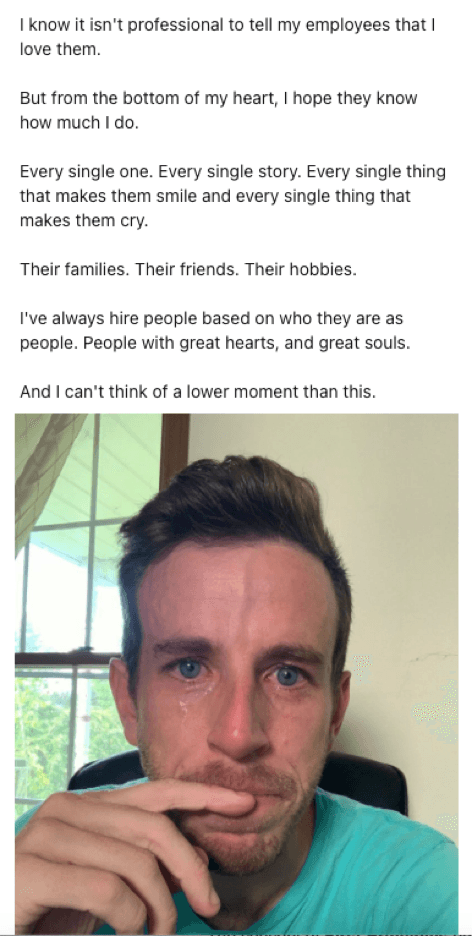
Writing about the tearful post, Fast Company noted a trend: “LinkedIn cringe is the norm.” A few days later, the New York Times ran a feature titled “How LinkedIn Became a Place to Overshare.” Some praised The Crying CEO for his vulnerability, some scoffed at his shamelessness, and others simply respected the hustle. I fall into that last category, largely because I clicked on his profile two years later and saw his bio:
Scaling B2B Serviced Based Companies | CEO of HyperSocial | 5x College Dropout | You probably saw a picture of me crying once
Speaking of B2B, the emotional opposite of the Crying CEO post was delivered to us from on high six months ago, restoring perfect tragicomic balance back to the universe. A user named Bryan (profession: “Founder @ SuperSeller”) posted a beautiful photo of himself down on one knee in front of a verklempt woman. The caption?
I proposed to my girlfriend this weekend. 💍
Here's what it taught me about B2B sales:
Breathtaking stuff, like seeing Klay score 60 or watching Tiger stride up 18 with the lead. Getting to be on this planet at the same time as the greats—now that is what life’s all about.
7. The Class Clown
Sometimes I’ll lose track of where in the World Wide Web I am, firing off an Insta-syntax comment like “ahhh never stop hustling u wild wild animal <3 <3 <3” in response to some old pal’s seventh work-iversary at Bain. And then the LinkedIn reality hits, typically in the form of a prim response that is like “Always nice to hear from you, Katie; please be well!” and makes me feel like I woulda just been better off faxing over a Xerox of my ass.
In 2016, The Ringer declared LinkedIn “where fun goes to die,” adding that it was the rare stretch of the information superhighway that “the weird internet”—that loose consortium of chuckleheads, irony lads, satirists, meme keepers, and trolls alike—hadn’t really colonized. In 2019, The New York Times asked: “Why Aren’t We Talking About LinkedIn?,” calling the site a “controversy-free zone” whose only risk was being “too cheesy.” (Shouts to the Andy Borowitz stray in that piece.)
One issue is that it can be really hard to know what’s real and what’s a bit when we’re dealing with career whisperers and productivity monsters. But we still have fun, don’t we, folks? Over the past few years, as the barriers between the personal and the professional have eroded on LinkedIn (as well as throughout society), there has been a small but mighty uptick in the shitposting shenanigans that are tolerated on the site.
Sometimes, the result is just goofy. “One of the worst business deals in history? Jack and the Beanstalk,” began a recent note by LinkedIn provocateur Ken Cheng (a guy whose posting volume has grown so engagement-baity-oops-I-mean-prolific that /r/LinkedInLunatics users sometimes beg for mercy). Other times, it’s inspired. One “hotel room hack” involving a coffee maker and raw chicken achieved true escape velocity; another faux-arrogant, all-time missive involving hotels and food had commenters threatening the original poster with lines from New York's penal code. Absurdist versions of “my morning routine” or “my monthly budget” posts have become so prevalent that now all the earnest ones feel like a joke. And you know what? They should.
8. The Guy Who Normally Would Not Do This, But …
A rule of thumb about digital apps is that on a long enough timeline, they all become just one more inbox. And a rule of thumb about inboxes is that eventually, they’ll light up with an unsolicited message from someone either negging you, flirting with you, or full-on asking you out. LinkedIn is no exception to this, and, if anything, it’s an intensifier: When you’ve spent enough time marinating in an environment that glorifies cold-calling and treats prospect management as a pure volume game, it doesn’t take much for that chutzpah to manifest in more personal ways.
“Linkedin is the opposite of online dating,” tweeted Steven Godofsky, “in the sense that greasy computer nerds get mobbed with a torrent of unsolicited messages from attractive women.” This wasn’t wrong, per se, just incomplete: It turns out LinkedIn sees plenty of run-of-the-mill attempts at online dating, too.
“Is LinkedIn the love child of Instagram and Tinder?” mused some TikTok creators. (One writer praised LinkedIn for actually having clear face photos, contra Tinder.) A Reddit user on the /recruitinghell sub reported that a “Dating Headhunter” tried reaching out to them over LinkedIn. One woman shared screengrabs of someone on the platform (profession: “MBA Candidate”) who shot his shot in her DMs: “Hey Hannah - Skipping the line on a dating app and coming straight to you,” he wrote. “Aggressive move, ikik. Life’s too short not to go for what I am highly interested in. Happy to connect regardless of your openness to meet.” (Hannah, for her part, captioned the whole thing: “this mans really came to LINKEDIN.”)
In a way, all of this has a full-circle feel: Before Hoffman founded LinkedIn, he ran a ’90s social network called SocialNet that was, in part, focused on finding people a match. (He eventually sold it to Spark Networks, whose portfolio includes Christian Mingle and Jdate.) While everything worked out just fine for Hoffman in the end, I’m kind of bummed that SocialNet was the one that got away: “People you click with” might be the best tagline for a social network I’ve ever heard.
9. The Ghost on Her Grind
A quirky aspect of LinkedIn is the way the sausage-making equipment is often displayed right alongside the sausage. This can be (mostly) additive, a Busytown-style glimpse into all the people who work together to make things happen. Look, it’s the exhausted sneaker executive who is proud to present the company’s latest, greatest ad campaign! Look, it’s the agency creative reflecting on how she designed the logo and the athlete rep remembering how sweaty everyone was while shooting the commercial! And look, it’s … that dang kid from my econ section, who had zero connection to the project, already out there posting a video clip about how the brand really could’ve benefited from a fractional CMO. We all contribute to GDP in our own way!
But sometimes, what LinkedIn winds up demonstrating is that there sort of is no sausage, that we’re consuming volumes of empty calories. The more I scroll, the more I see it: the spectral armies of ghostwriters who buttress every corner of the site. LinkedIn is at once haunted and fueled by these operatives, who move with the stealth of a Navy SEAL team or with the persistence of a telemarketer. All those VC associates posting suspiciously similar thought leadership musings? There’s a ghostwriter for that. The start-up founders who regularly drop wide-eyed, gussied-up Wikipedia summaries of infamous corporate takeovers and then ask readers to name their fav leveraged buyout in the comments? There’s a ghostwriter for that, too—one familiar with driving engagement.
As far as I can tell, the only population more heavily represented in the LinkedIn ecosystem than the ghostwriter is the mighty headhunter—in particular the type who begins each post with a totally made-up conversation that (a) relates to the hiring process and (b) generates strong reactions from readers. Come to think of it, there’s almost certainly a ghostwriter for that, too.
For now, anyway. What is dead may never die—but these wordy ghosts? They’re in danger, already ceding ground to a force that is stealthier, more persistent, and impossible to tire out.
10. The Enemy, Who Is (Trained by) Us
Things happen, people change. The very same Harvard Business Review columnist who sniffed in 2007 that using online social tools for professional networking was “unseemly”—and who also said that if someone wanted to connect with him for business reasons, they ought to email or call him directly—has evolved: These days, he’s all in on the business uses of AI.
And Hoffman has been interested in the space for more than a decade; he was an early investor in OpenAI and has since started his own venture, the “empathy-focused” Inflection AI. Recently, the “about” section of Hoffman’s LinkedIn profile stated: “My two current priorities are: (1) using AI to benefit humanity and (2) protecting US democracy.” Since I guess we’re all out of democracy now—too soon?—Hoffman removed that part from his bio and created some extra room to focus on priority number one.
One thing’s for sure: There’s a lot to look into. According to a new study, more than half of the longer-length English posts on LinkedIn are now likely AI-generated. Heck, some of them are probably even in conversation with one another, dead internet theory style.
Somewhere out there is, say, a product manager who’s looking for a new job. He browses listings that were probably punched up at some point by AI, and when he finds good fits, he asks AI to help him paste phrases from the job description directly into his résumé and cover letter—in hopes that the employer’s AI, which is tasked with screening candidates, might notice those phrases and wave him through. As he waits to see whether he’ll get an interview—if he does, he’ll ask AI to help prepare—he uses AI to write daily LinkedIn musings about leadership and product management so he can show off his experience and insight. If he’s hired, he’ll at some point be asked whether there are any people on his team whose jobs might be performed more efficiently by AI. And all of this is just the beginning—unless it’s the end.
“I have an algorithm,” Hoffman said to a New Yorker reporter in 2015 as they waited to order dinner in a restaurant. “If it’s a good place, order the special. If it’s a bad place, order what they can’t screw up.” Really makes you think. Maybe Hoffman can repurpose this view into a LinkedIn post sometime, no ghostwriters or AI chatbots necessary. I have an algorithm is how it can begin. Here’s what it taught me about B2B sales.

